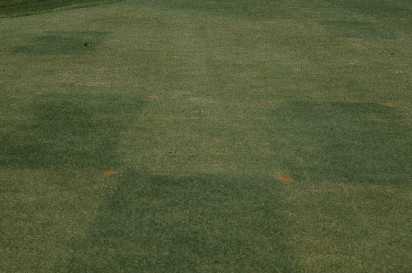Preparing your lawn for winter
Learn key things to do in the fall to prepare your lawn for survival in the winter and a quick green-up in the spring.
Introduction
Fall is the time to start putting your lawn to bed for the winter. Summer has come and gone, and chances are, it has taken its toll on your lawn. Drought, disease, insects and weeds can leave your lawn looking thin and patchy (Figure 1). Here are some tips for getting your lawn back into shape, preparing it for survival during the winter and a quick green-up in the spring.
Figure 1. Thin, patchy lawn.
Fertilize turf to help heal damaged lawns
Damaged areas in turf will recover more quickly with two applications of fertilizer in the fall. The first application should be made in early fall (from mid-August to mid-September). This will help turf recover from damage that occurred during the growing season. Nitrogen and potash stimulate turf growth and repair, and harden off the turf for winter. Fertilizer should be applied at a rate to deliver 0.5 kg of nitrogen per 100 m2.
Overseed lawns that have extensive turf damage or loss
Some damage is too extensive to be fixed with just an application of fertilizer. For those areas, uniformly distribute the desired seed mixture in two directions, making sure the seed is in contact with the soil. Seed-to-soil contact can be enhanced by core aerating before spreading seed. The recommended species for overseeding are perennial ryegrass (general recommendation), fine fescue (for shade or low maintenance) and tall fescue (for drought tolerance). The seeding rates are as follows:
- perennial ryegrass: 2-4 kg/100 m2
- fine fescue: 1-3 kg/100 m2
- tall fescue: 2-3 kg/100 m2
Rolling newly seeded areas also helps. Water the seeded areas frequently to ensure good germination. The ideal time for overseeding is also mid-August to mid-September.
Control thatch in the fall
Thatch harbours disease-causing organisms such as snow mould. In turf with excess thatch, the growing point of the plant is elevated above the soil. The soil has insulating properties that the thatch does not. Lawns with an abundance of thatch are more prone to winter injury. The ideal time for thatch control is the same as for overseeding and the first application of fall fertilizer. There are two major ways of controlling thatch - core aeration and dethatching. Core aeration cuts cylindrical plugs out of the lawn (Figure 2), breaking up the thatch and bringing up soil, which contains microorganisms, that help break down the thatch. De-thatching, or verticutting, is done by a machine that cuts into the thatch vertically, bringing up the debris, which is then raked up and disposed of.
Figure 2. Cylindrical plugs created by core aeration.
Remove fallen tree leaves before snowfall
If fallen leaves are not removed, the lawn will not get light and will eventually die. An alternative to leaf removal is pulverizing tree leaves with a mulching mower and letting them decompose on your lawn. Research has shown that a layer of tree leaves up to 15 cm deep can be mulched in a lawn without adversely affecting it. Mow dry leaves with a mulching mower with sharp mower blades.
Leave the lawn cut at the right height
Raise the mowing height slightly in the fall. Rooting depth is proportional to mowing height - the longer the leaves, the deeper the roots. Longer grass blades provide some insulation for the crown (growing point) of the grass plant. However, if the grass is too long going into the winter, it will become matted, which encourages winter diseases such as pink and grey snow mould.
Apply a late season fertilizer application
To ensure good winter survival and early-spring green-up, make this fertilizer application when the turf has stopped growing but is still green, usually in mid- to late October. Timing is critical. Fertilizer applied too early will promote succulent growth in the fall that will make the lawn more susceptible to winter injury. Fertilizer applied too late will be of no benefit to the turf. If you make a late-fall fertilizer application, spring fertilization can be delayed until late May to early June. The application rate for this time of the year is the same as for the early fall application (0.5 kg of nitrogen per 100m2).
Principles of Late-Season Fertilization
- Nitrogen is taken up by the roots even though shoot growth has ceased. This is because roots remain active at cooler temperatures than shoots.
- Nitrogen enhances fall colour and hence increases chlorophyll content.
- Increased chlorophyll content means increased photosynthesis.
- Increased photosynthesis means increased sugars. Since turf is not growing at the time of the fertilizer application, the sugars that are produced are not used for growth but are stored to enhance winter survival and spring recovery.
- These sugars make the grass plant less susceptible to freezing. A good analogy is that a bottle of juice in the freezer will take longer to freeze than a bottle of water. The grass plant cells are full of sugars and hence take longer to freeze, and freeze at lower temperatures.
- Late-season nitrogen applications promote deep rooting during the fall, so plants go into the spring and summer with deeper, healthier roots.
- Spring green-up is early, because the nitrogen that is stored in the roots is ready when shoot growth resumes.
Figure 3. The greener plots received a late fertilizer treatment.
Take advantage of the good growing conditions in the fall to help your lawn recover from the summer. With the addition of two properly timed fertilizer applications, your lawn will survive the winter better, green up earlier in the spring and have deep roots that will help it withstand next year's summer drought (Figure 3).
This Factsheet was written by Pam Charbonneau, Turfgrass Specialist, OMAFRA, Guelph.


